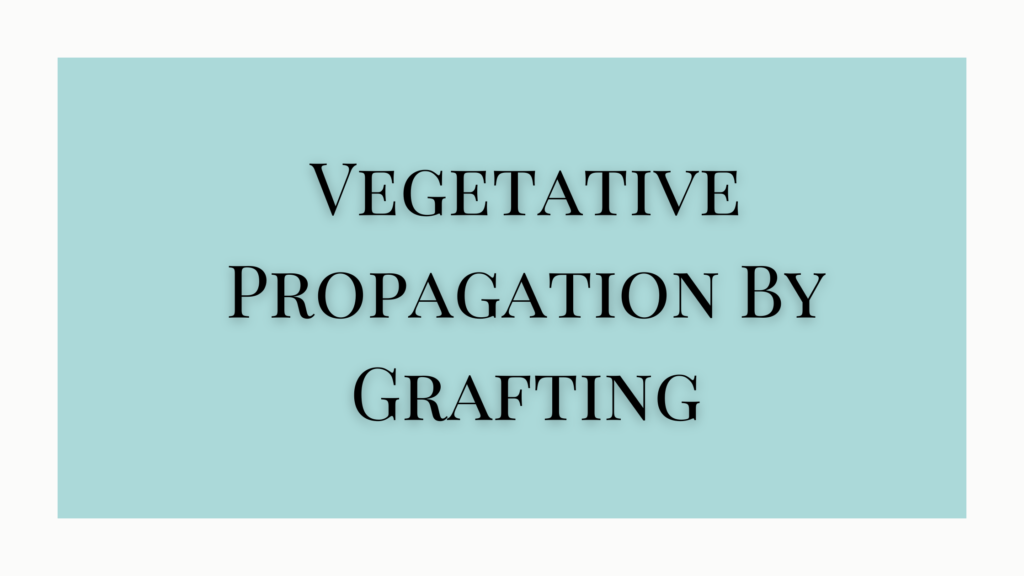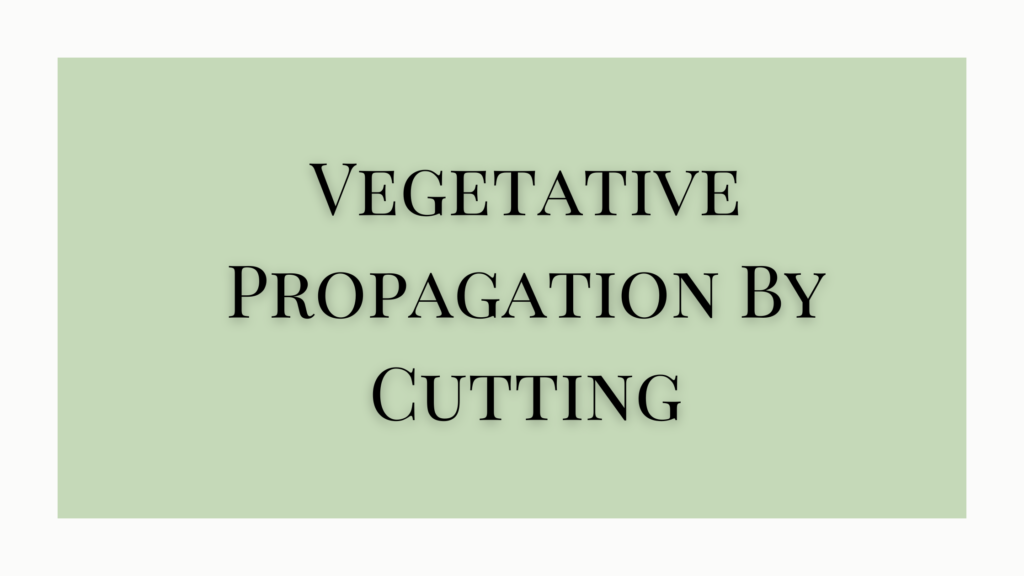Vegetative propagation by grafting is the art of growing plants where parts of different plants are put together in such a manner that they unite and continue to grow as a single plant. It is a type of propagation where the root and shoot systems of the growing plant come from different species or varieties.
The technique of grafting originated in ancient times. There is evidence that grafting was known to the Chinese as early as 1000 BC. Aristotle (BC 384-322) discussed grafting in his writings with considerable understanding.
Terminology
- Rootstock is the plant that supplies the root system on which the scion is grafted.
- Stock plants are those grown to serve as a source of propagation material such as cutting, layering, budding, etc.
- Seedling refers to the plants that are grown from seeds. But when they are used for grafting, they are called seedling rootstock or rootstock seedlings.
- Scion is the short piece of shot containing several dormant buds employed for uniting with the rootstock and later forming the upper part of the new plant.
- Stion is the common term used for the combination of scion and stock growing as a single plant.
- Matrix is the substance prepared to be placed on the rootstock for the insertion of the graft wood or bud wood.
- The callus is the mass of undifferentiated parenchymatous cells from and around the wounded plant tissues. The production and interlocking of these parenchymatous cells is one of the important steps in the healing of successful grafting.
What is the Purpose of Grafting?
- Perpetuation and preservation of clones that cannot be easily propagated by other methods. For example, certain species of mango, apple, peach, etc do not root easily on cutting or layering.
- Obtaining benefits of certain promising rootstocks. Certain good varieties of fruit plants on their root system do not well, due to, unfavorable soil conditions, susceptibility to soil-borne diseases, pests, or nematodes, adaptability to adverse conditions, etc.
- To control the size of plants by the use of certain dwarfing rootstocks.
- To change inferior varieties by top working varieties.
- Rejuvenation of old orchards.
- Add a pollinizer to dioecious trees that require cross-pollination.
- To overcome pollination problems due to incompatibility (by grafting a staminate branch on one of the branches).
- Induction of flowering in seedlings (for speeding up flowering for breeding purposes).
- Repairing the damaged parts of trees and healing wounds by bridge grafting.
- Virus transmission studies.
- Changing the root system of a plant that has a weaker root system.
- For novelties (fancy varieties) – different types may be grafted on the same plant.
Requirements for Successful Grafting
- The graft union is the basis for successful graftage. There are several requirements for a successful graft union.
- Stock and scion must be compatible.
- The cambial region of the scion must be in intimate contact with that of the stock.
- Grafting operations must be done at a time when the stock and scion are in the proper physiological stage.
- Immediately after the grafting operation is completed, all the cut surfaces must be protected from desiccation.
- Proper care must be given to grafts for a while after grafting.
Vegetative Propagation by Grafting
Graft Union: Stock and Scion Interaction
The formation of graft union is a process of healing wounds. The success or failure of grafting depends on the graft incompatibility between the scion and stock, closeness of fit, and cambial contact.
In a graft, stock, and scion are planted in close contact with each other and are held firmly together until they unite. The principal steps in the formation of sequence during graft union are,
- The exposed cells of the cambium of stock and scion divide and produce a mass of callus tissue composed of parenchyma.
- The parenchyma cells interlock and intermingle with each other.
- Certain parenchyma cells of the callus are differentiated to form new cambial cells.
- The new cambial cells differentiate into the xylem and phloem to reestablish a vascular connection between the scion and stock.
Selection of Scion
- The scion from an older tree should be avoided.
- It may be from the current or past season or an older one, depending on the species.
- Scion should be of the same age and thickness as the rootstock.
- In the case of dimorphism (presence of horizontal and vertical branches), vertical branches are to be selected which produce normal trees.
Selecting Rootstocks
- Seedling stocks show variation among seedlings causing variability in grafted trees.
- Clonal stocks are the rootstocks produced vegetatively by cuttings or layers.
Graft Incompatibility
Graft incompatibility refers to the inability of the scion and stock plants to graft or join successfully together to produce a composite plant. It can be manifested in different ways.
- Complete failure in some species.
- A low percentage of success.
- Union may take place but eventually, the tree dies.
- Regeneration of joints may not happen.
- The leaves may turn yellow. Leading to stunted growth as well.
- Nutritional disorders.
- Overgrowth for the scion or stock.
- Excessive swelling at the graft union.
- Breaking the tree at the union.
Causes of Graft Incompatibility
- Structural or anatomical features
- Physiological factors
- Nutritional needs
- Viral attacks
Grafting Methods In Plants
There are different grafting methods in plants, Each method is suitable for certain types of plants, in most cases. But there also are different plants that can be grafted using different methods.
Whip Grafting
Whip grafting is a very popular method of grafting which is simple and easy to do. Here, both the stock and scion should be of equal diameter. A long cut is made across the top of the stock, using a sharp knife. A similar cut is also made on the selected scion of the same thickness.
The cut surfaces should be smooth and even. The stock and scion are placed together. Tie the point of union with a grafting tape or polythene tape. Wrap the whole thing together and keep it like that for a while, until the two plants unite.
Side Grafting
In side grafting, the graft material scion base is inserted into the stock, about 2.5 cm under the bar on the side. It is a popular method of grafting and is quite useful where the stock is too large for whip grafting. Eg. Mango, Magnolia, etc.
Leaves are trimmed off from the rootstock where grafting is to be done. Two slanting cuts are given halfway deep into the wood about 15 cm above the ground level. In such a way that a “V” shaped cut is formed. A little bark and wood are removed from the scion to fit in.
The slanting cuts give the scion a wedge shape and are inserted into the cut of the stock. The point of contact is wrapped with polythene film. The graft union takes place within 6-8 weeks. When the two plants have united properly, the polythene film is removed. Half of the rootstock above the union is cut down so that the scion becomes the leading shoot of the plant.
Wedge Grafting
- In grafting for some thick-barked plants, a vertical cut in the bark is necessary.
- The scion here is inserted between the bark and the wood of the stock.
- A vertical cut of 3-5 cm long is made through the bark to the wood. The bark on both sides of the cut is likely separated from the wood.
- The scion is cut in such a way that a long cut with a shoulder on one side and a shorter cut on the opposite side.
- It is then inserted between the bark and the wood of the stock, tied, and sealed with a wrap.
Approach Grafting
Approach grafting is a popular method of grafting for mango, sapota, jackfruit, etc. Healing in this type of grafting is most rapid especially when both components are in an active state of growth.
A thin slice of bark and wood about 6-7 cm long is removed from the stock at a height of 25-30 cm from the soil level. A similar cut is made on the scion. The cuts or the exposing cambium should be smooth and even so that when they are held together they fit closely without any gap in between them.
In this position, they are held firmly with waxed cloth, jute fiber, or twine. Grafting wax is applied at the grafting point to prevent wilting of the tissues.
Types of Budding in Plants
Budding in plants is a type of grafting in which a single or simple bud is taken from one plant and inserted into the stem tissue of another plant so that the two plants unite and grow together as a single plant.
In other words, budding is a modification of grafting where a single bud is removed from the stem with a small portion of bark, often termed bud grafting. The budding depends on the bark slipping. This indicates the condition when the bark can be easily separated from the wood.
Rootstock for Budding
The rootstock plant should have the desired characteristics of vigor, growth habit, and disease resistance as well as be easily propagated. It may be a rooted layer or more commonly a seedling.
T Budding
T-budding is the most common method of budding and is widely used in propagating fruit trees, roses, and many other ornamental shrubs as well. It is also called shield budding due to the shield-like appearance of the bud when it is inserted into the stock.
A vertical cut is made on the selected portion of a rootstock with the help of a budding knife. Then a horizontal cut across the top at a right angle to the first cut is made. Thus it resembles the letter ‘T’. The two flaps of the bark are then loosened slightly to receive the bud.
The bud is removed from the bud stick by cutting slowly below the mature portion. Then the bud is inserted into the ‘T’ cut. The shield is well covered by two flaps of bark, keeping buds exposed. The portion is wrapped in polythene tape or jute, keeping the bud exposed.
Patch Budding
In patch budding, a rectangular patch of bark is removed completely from the stock and replaced with a patch of bark of the same size containing a bud of the variety to be propagated.
Make two parallel horizontal cuts and these are then connected to each side by vertical cuts. The patch containing the bud is cut from the stock when the bud patch is ready. The bark is removed from the stock and the bud is inserted. The union is wrapped with polyethylene ribbon or waxed cloth but leaves the bus exposed.
I Budding
In this type of budding the bud patch is cut just as in patch budding, ie, in the form of a rectangle or square. Two transverse cuts are joined at their centers by a single vertical cut to produce as shown in the figure.
The two flaps can then be raised for insertion of the bud patch beneath them.
Top Budding
To rejuvenate old orchards or to change inferior varieties to superior ones. The objective here is to make the top work. In young trees, it is cloned on vigorous shoots, and in old trees, the main branches are cut about a year before budding to encourage the development of young shoots which are used as stocks. T budding or patch method is used for budding.




